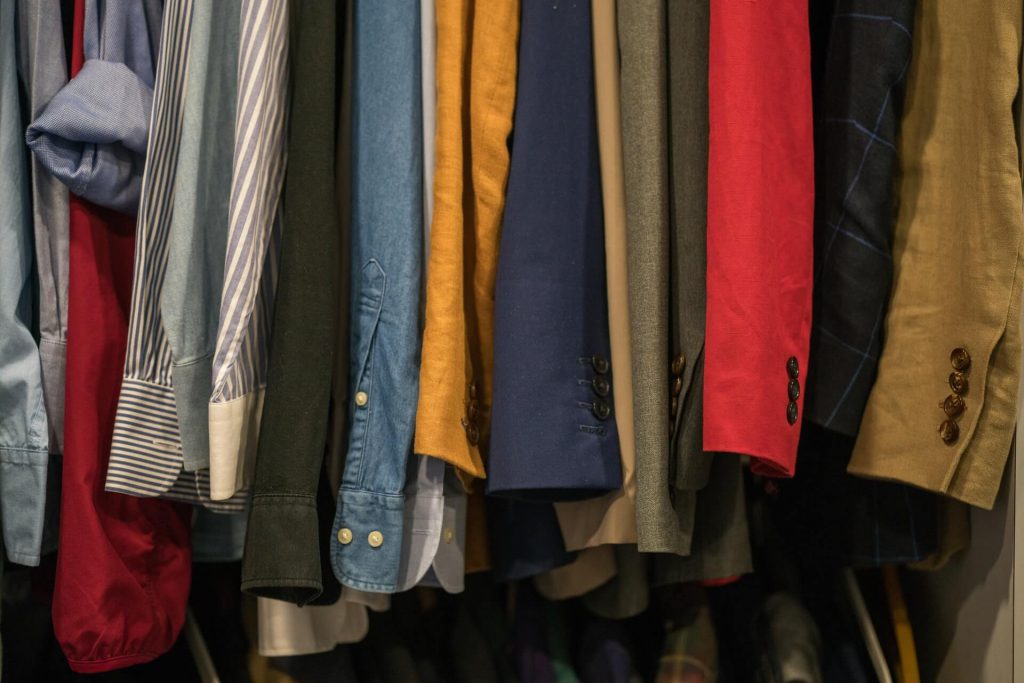An outfit on a particular body suggests a certain lifestyle or role, and only by separating a garment from the wearer can we appreciate the clothing for its own merits.
Joanne Entwistle tells us that “dress cannot be understood without reference to the body” [1]. Without a body, a garment’s potential is unfulfilled, and clothes that are not worn have a “sinister otherworldliness” [2]. Much as I respect Entwistle’s writing, I am inclined to disagree. When we first encounter a garment, it is often hung limply on a hanger or draped over an abstract plinth. If I take a trip to Zara for a new cardigan, I will find it folded in a pile on a display table. This method of display means that I am primarily drawn to a garment not because of how it may fall on my body, but because of the qualities of the fabric.
When we see a garment on a model or mannequin, it is understood that it’s communicating the identity of a person. An outfit on a body suggests a certain lifestyle or role. In rigged displays, clothes are removed from the context of being worn. We are forced to see them for their own merits. Fit becomes secondary to texture and colour, and the identity of the wearer is made distinct from the identity of the garment.
Sign up for the Fashion Statement email
Read more
It is perhaps for this reason that Gap displays clothes the way it does. In Gap, clothes are often folded and stacked, draped or hung. This allows shoppers to make direct comparison between the colours, and highlights everything that makes the Gap brand distinct from its competitors. While other brands innovate in the cut of their garments, Gap’s silhouettes tend to be fairly constant and reliable. It is their colour and logo that primarily set them apart, and these features are most visible when garments are folded on a shelf.
Only by separating the identities of the wearer and the garment can we appreciate clothing for its own merits. This is something that has driven Issey Miyake to display his garments in “installations” rather than catwalk shows [3]. Miyake’s primary interest is in the possibilities of textiles. As a student of graphic design, his education focused on the use of abstract and geometric shapes, and block colour. Miyake has sought to transcend the boundaries of the established fashion industry by locating his work in unexpected contexts. His Pleats Please collection is often photographed as a series of food objects, including sushi, ice cream and wine. His 1997 Arizona collection was shown suspended on wires rather than on models “to emphasise their sculptural abstraction” [4]. This shifts the focus away from wearability towards the garment as a fixed shape, a sculptural form and a graphic surface.
Consumers have come to appreciate the significance of Miyake’s work as an object. In 1999, he released a line called A-POC (“a piece of cloth”). Rather than ready-made garments, this line presents knitted tubes with seams and hems woven into the fabric. Tamsin Blanchard described it in the Observer in 2001: “Each section of tube contains a mini wardrobe within it. All the consumer has to do is cut out each item, following a set of easy-to-follow instructions.” A-POC’s particular ingenuity is most visible in its flat state – before the consumer has removed their garment from the tube. It is this flat, incomplete form that has enticed consumers. Many have chosen to leave it uncut, displayed on the walls of their homes as a piece of art [5].
As shop displays move away from the convention of dressing clothes on mannequins, there will be a shift in the way that we view fashion. In rigged displays, the garment may be appreciated as entirely removed from our experience of wearing it. An increase in concern for surface design – patterns and embellishments – is indicative of this shift. We are beginning to learn to appreciate the qualities of the garment itself, distinct from how it makes our bodies look in the mirror.
References:
[1] Enwtistle, Joanne, and Wissinger, Elizabeth. Keeping Up Appearances: Aesthetic Labour in the Fashion Modeling Industries of London and New York; (The Sociological Review 54 (4) (2006), pp. 774-794.
[2] Bancroft, Alison. Fashion and Psychoanalysis, London; I.B. Tauris, 2012, p. 2.
[3] Mackrell, Alice. Art and Fashion, London; B T Batsford, p. 154. (2005)
[4] Quinn, Bradley. Techno Fashion, Oxford: Berg, p. 150. (2002)
[5] Vance, Lin. Issey Miyake’s A-POC: A Piece of Cloth; Graphis [online], May/June 2001.

